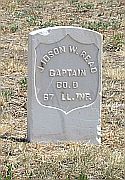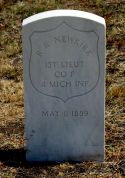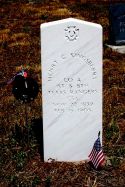|
Historic Military HeadstonesThe familiar white marble military headstones known throughout the country were not typical until about 150 years ago. Prior to the Civil War, the graves of US soldiers who died (usually on the frontier) were marked with wooden boards with a rounded top. These were labeled with a registration number or inscription. During this era, there was no centralized system for recording burials. While this sufficed for the frontier, it was not up to the demands of America's bloodiest conflict. Shortly after the first battle of Bull Run (aka Manassas), the War Department issued a General Order which made the commanders responsible for burials and marking graves. In the same directive, the Quartermaster General of the Army was directed to provide headboards, blank books and forms for the preservation of burial records. This was the first organized system for marking graves. Soldiers in the Union Army were issued markers in one of three different sizes, ranging from 10-13 inches wide and 39-42 inches high. All were only three inches thick. The inscriptions were all in relief, over a recessed shield.
Should a replacement marker need to be requested, the guidelines for replacing military headstones as well as a toll free number to call for guidance, are provided on the VA website. |



